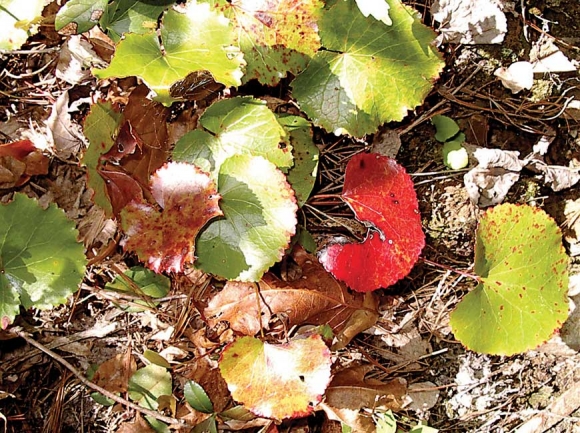Galax’s enduring popularity
 Galax. Donated photo
Galax. Donated photo
Galax is an evergreen groundcover found throughout the Blue Ridge. The plant can thrive in various settings, but the ideal habitat is a cool moist site with partial shade and acidic soil. It occurs in extensive patches that can reward the observer in every season. As Peter White observed in Wildflowers of the Smokies (1996), “In early spring, its round, evergreen leaves carpet the dormant forest floor. By summer, a tall pillar of tiny white flowers line many park trails. Then, as winter approaches, the deep green leaves turn bronze and crimson to contrast against the coming snows.”
During the early 1900s, many residents of southwestern Virginia and northwestern North Carolina gathered and sold galax leaves that were shipped out by rail. An official from the Norfolk and Western Railway Company who observed this activity suggested that one of the communities be named for the plant. In 1906, the Virginia General Assembly officially chartered the town of Galax, Virginia.
Two attributes of galax are of particular interest: the odor it sometimes exudes; and the colors its leaves exhibit each fall.
Have you ever been walking a mountain trail when you encountered a musky smell that reminded you of skunk, mold or scat? Whenever this happens to me, I consider six possible sources: skunk, bear scat, wild boar rooting, carrion vine, skunk goldenrod or galax. Quite often the smell will be emanating from a nearby stand of galax.
A note titled “Wild Ideas: The Odor of Galax” by J. Amoroso that appeared in Chinquapin: The Newsletter of the Southern Appalachian Botanical Society in 2000, reviewed speculations by several botanists about the possible causes for these odiferous odors. A plant physiologist and chemist, working separately, have surmised that they might come from sulfur compounds similar to those exuded by skunks. Crushed living galax leaves produce no smell — but sulfur compounds could be released as the older leaves decompose.
Because its large shiny leaves assume beautiful colors in late fall — reds, bronzes, purples or browns — galax has been gathered commercially since the nineteenth century. Initially, entire families ventured into the mountains to collect them in two sacks. They were then sold to botanical companies specializing in herbal medicines and ornamentals that marketed them as seasonal evergreen decorations. For the mountain families the few dollars earned in this manner were more than welcome.
Related Items
Today, galax leaves are in high demand in the floral industry, especially in Europe, because they are attractive, sturdy and can be stored for months. Rounded or heart-shaped leaves are preferred as background foliage in floral arrangements. They can be hot-glued onto a plastic tray or wrapped to make a “floral rose.” And they are sometimes sown together to form tablecloths for weddings or blankets for funeral caskets.
As a sign of the times, upwards of 90 percent of the galax pickers today are Hispanic. After these workers started arriving in Western North Carolina in the late 1980s, area nursery owners encouraged them to harvest galax in the off-season. An experienced harvester can collect up to 5,000 leaves a day and earn from $20 to $120, depending on the season and the size and color of the leaves. Concerns about the sustainability of galax have prompted the U.S. Forest Service to restrict both the quantity gathered and the harvest season. Permits cost $25 and are good for 30 days or 100 pounds of leaves. Each leaf should be at least 3 inches in diameter, with 3 inches of stem, and no roots attached.
Because of galax poaching on National Park Service lands like the Great Smoky Mountains National Park and the Blue Ridge Parkway, as well as on U.S. Forest Service lands where harvesting is not allowed, a tagging program for the plant has been implemented. Leaves are sprayed with an adhesive and then dusted with a “micro-taggant” — a 6-layer polymer that bears a “signature” coding. Using this method, plants in areas where harvesting is illegal are marked and can be tracked back to their source when sold.
Most of the information in this column is derived from an excellent 34-page pamphlet by Mary L. Predny and James L. Chamberlain titled Galax (Galax urceolata): An Annotated Bibliography, published in 2005. A free copy can be obtained by request from Communications, USDA Forest Service, Southern Research Station, PO Box 2680, Asheville, N.C., 28802-9903.
(George Ellison is a naturalist and writer. He can be reached at This email address is being protected from spambots. You need JavaScript enabled to view it..)









